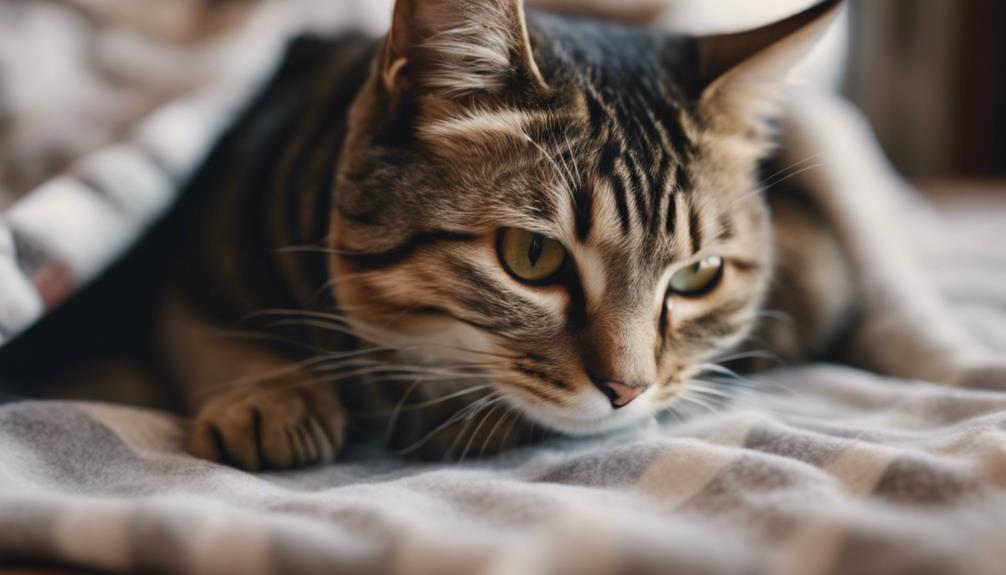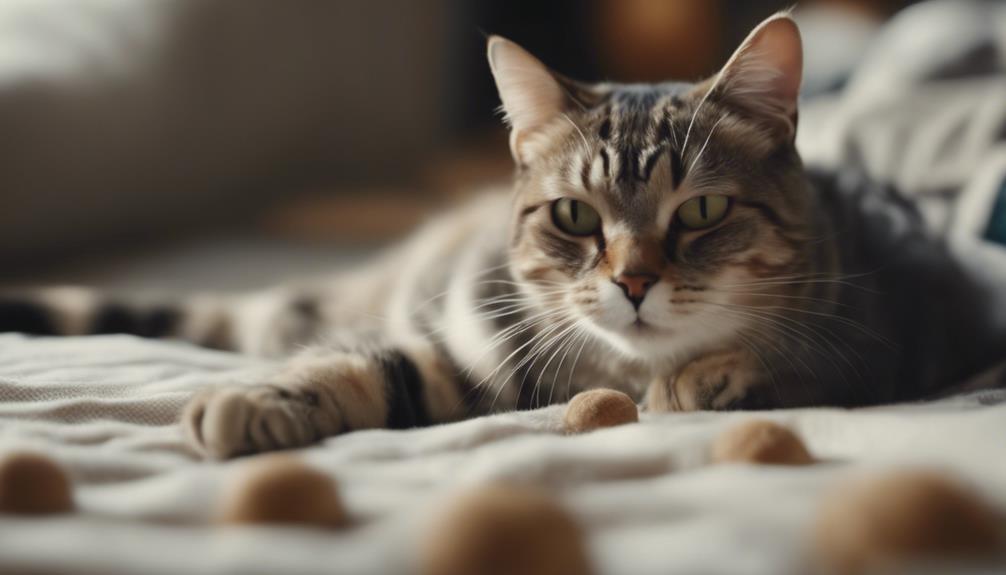The enigmatic behavior of cats sucking on blankets has intrigued pet owners for years, prompting questions about its underlying causes and implications.
While often dismissed as harmless, this peculiar habit can offer valuable insights into a cat's emotional and physical well-being.
By unraveling the mysteries behind this behavior, a deeper understanding of feline psychology and care strategies emerges.
Stay tuned to discover the hidden motivations behind cats' blanket sucking tendencies and how to ensure your furry companion's contentment and health.
Key Takeaways
- Cats suck on blankets for self-soothing, anxiety, boredom, or emotional needs.
- Ingesting fabric poses risks like gastrointestinal upset or obstruction.
- Consult a vet to rule out underlying health issues causing the behavior.
- Address the behavior with behavioral solutions and provide mental stimulation for the cat.
Reasons Cats Suck on Blankets
Cats may suck on blankets for various reasons, including self-soothing, anxiety, gastrointestinal distress, boredom, and unmet emotional needs. This behavior can stem from kittenhood habits, where cats learn to self-soothe by sucking.
Certain breeds may exhibit this behavior due to anxiety, while gastrointestinal distress could indicate underlying health issues like food allergies. Boredom or unmet emotional needs could also drive cats to engage in blanket sucking.
To address this behavior, providing enriching toys, interactive playtime, and mental stimulation is crucial. If a cat excessively sucks on blankets, consulting a vet is advisable to rule out any underlying medical issues. Understanding the reasons behind this behavior is essential in implementing effective management strategies.
Understanding Behavioral Triggers
By exploring the various environmental stimuli and psychological factors that influence feline behavior, one can gain valuable insights into understanding the behavioral triggers exhibited by cats. These triggers can vary widely and may include:
- Environmental Changes: Cats may suck on blankets in response to changes in their environment, such as moving to a new home or rearranging furniture.
- Anxiety and Stress: Cats experiencing anxiety or stress may resort to sucking on blankets as a coping mechanism.
- Boredom and Lack of Stimulation: A lack of mental and physical stimulation can lead cats to engage in sucking behavior out of boredom.
- Previous Trauma: Cats with a history of trauma or neglect may suck on blankets as a way to self-soothe and find comfort.
Potential Health Risks Involved

Understanding the potential health risks associated with cats engaging in sucking behavior, particularly on blankets, is crucial for ensuring their overall well-being and addressing any underlying medical concerns. One significant risk is the potential for ingestion of fabric fibers, which can lead to gastrointestinal upset or blockages. Cats that exhibit pica (eating non-food items) through blanket sucking may signal underlying health issues that require attention.
It is essential to consult a veterinarian if a cat excessively engages in this behavior to rule out any medical problems. A thorough medical evaluation can help confirm if there are any health issues contributing to the sucking behavior, allowing for appropriate treatment and management strategies to be implemented promptly.
Seeking Veterinary Guidance
Seeking professional veterinary guidance is crucial when addressing a cat's excessive sucking behavior on blankets to ensure their health and well-being are properly managed. When consulting a veterinarian regarding this behavior, consider the following:
- Comprehensive Examination: The vet will conduct a thorough physical examination to rule out any underlying health issues causing the sucking behavior.
- Behavioral Assessment: They will assess the cat's overall behavior and well-being to determine if the sucking is linked to stress, anxiety, or other behavioral issues.
- Diagnostic Testing: In some cases, diagnostic tests such as blood work or imaging may be necessary to identify any medical conditions contributing to the behavior.
- Treatment Plan: Based on the assessment, the vet will develop a tailored treatment plan which may include behavioral modifications, dietary changes, or medication if needed.
Implementing Behavioral Solutions

When addressing a cat's excessive sucking behavior on blankets, implementing behavioral solutions is crucial for promoting their overall well-being and managing any underlying issues effectively.
To address this behavior, identifying the root cause is essential. Cats may suck on blankets due to anxiety, boredom, or a need for self-soothing. Providing enriching toys, interactive playtime, and mental stimulation can redirect their focus and reduce the urge to suck on fabrics.
Additionally, creating a safe and comfortable environment, free from stressors, can help alleviate any anxiety-related behaviors. Consistency in routines, positive reinforcement, and avoiding punishment are key aspects of implementing behavioral solutions to address and manage a cat's blanket-sucking behavior successfully.
Managing Sucking Behavior Effectively
To effectively manage a cat's sucking behavior on blankets, it is essential to implement targeted behavioral interventions that address the root cause of the behavior. Here are four effective strategies to manage this behavior:
- Provide Alternative Soothing Items: Introduce toys or blankets specifically designed for cats to suck on.
- Increase Mental Stimulation: Engage your cat in interactive play sessions to reduce boredom and anxiety.
- Create a Calm Environment: Establish a peaceful space for your cat with hiding spots and elevated perches.
- Consult with a Veterinarian: If the sucking behavior persists or intensifies, seek professional advice to rule out any underlying medical issues.
Exploring Educational Resources

Exploring educational resources can provide valuable insights into understanding and effectively managing complex pet behaviors like cats' sucking behavior on blankets. Resources such as books like 'Decoding Your Cat' can offer in-depth explanations on the reasons behind cats' behaviors, including sucking on blankets.
These educational materials often cover a range of topics from basic feline psychology to advanced behavior modification techniques, aiding pet owners in comprehending and addressing their cat's actions. By delving into these resources, individuals can gain a better understanding of the underlying causes of sucking behavior and learn practical strategies to help their feline companions overcome such habits.
Additionally, seeking information from reputable sources can empower pet owners to make informed decisions regarding their cat's well-being and behavioral needs.
Further Reading on Cat Behavior
Delving into reputable publications can enhance understanding of various aspects of feline behavior, including the intricate nuances of cat behavior related to sucking on blankets. Further reading on cat behavior can provide valuable insights into various behaviors exhibited by our feline companions.
Here are some recommended articles to deepen your knowledge:
- 'Plastic Ingestion: Exploring why cats eat plastic and related health concerns.
- 'Purring Behavior: Understanding the reasons behind cats' purring.
- 'Litter Box Habits: Reasons why cats sleep in litter boxes and their implications.
- 'Vocalizations: Interpretation of cat noises and their meanings.
Conclusion
In conclusion, understanding the reasons behind cats sucking on blankets is crucial for ensuring their well-being. By addressing behavioral triggers, potential health risks, and implementing effective solutions, pet owners can provide appropriate care for their feline companions.
Seeking veterinary guidance, managing sucking behavior, and exploring educational resources are essential steps in managing this intriguing cat behavior.
By taking a comprehensive approach, pet owners can promote their cats' happiness and overall quality of life.




